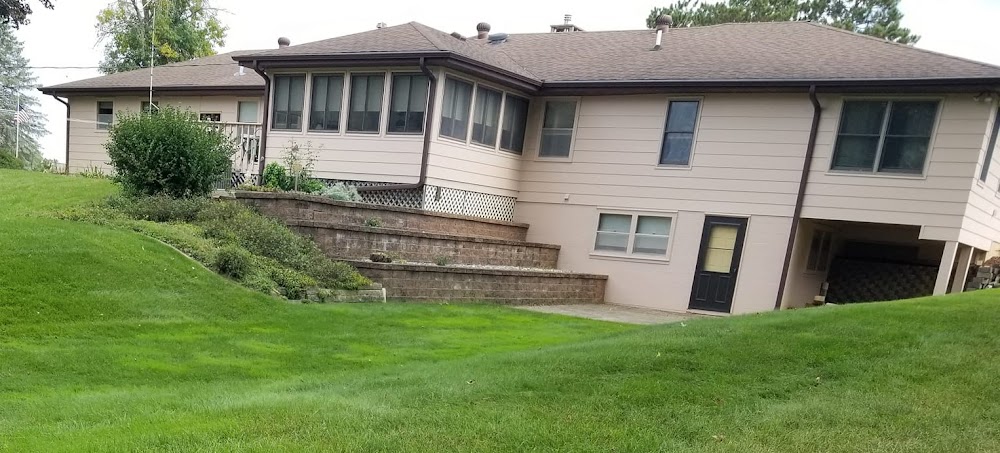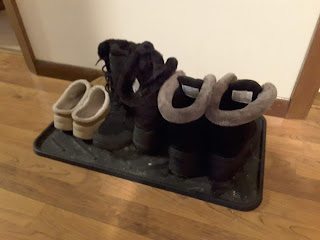 |
| view out front |
It is a clear vibrant blue sky, but bitter cold day here with high of 12 degrees and we have reached that. I had to run an errand uptown and I use the term run freely, I drove, too cold for me to walk let alone run, it is too cold for me to get out there and shovel the other front walkway and more snow is on the way tomorrow. Well, people can use the other front door, the steps closest to our garage and enter through the hallway into the kitchen instead of the living room. I often wondered why we had 2 front doors on this home, but in this weather that is a good thing. If the rest of the walk is not cleared, no problem, people can enter in the first door and if someone is insulted, not my problem, get over it. .
 |
| Not a track nor a bird in the bush |
I bundled up in my newest parka and head cover, mittens I purchase in 2015 in Austria when Carlie and I were on our Danube Christmas markets cruise. Sadly she passed suddenly over a year ago and with her, my international travel partner. Just walking acrosss the street to the parish office from the school lot this morning was a wake up! As I returned home and looked at our snow I noticed something most unusual for here, no tracks, not a squirrel, rabbit, deer mark to be found, not even a bird in the bush. All critters have hunkered down against this tundra wave. .
If you follow the link you will learn: To freeze the balls off a brass monkey means it is very cold. now that I knew. But I never saw a brass monkey.....
"Early references to brass monkeys in
the 19th century have no references to balls at all, but instead variously say
that it is cold enough to freeze the tail, nose, ears and whiskers off a brass
monkey; or hot enough to scald the throat or singe the
hair of a brass monkey. All of these variations imply that an actual
monkey is the subject of the metaphor, with balls being the
surviving phrase.
It is widely believed that a brass monkey is a
brass tray used in naval ships during the Napoleonic Wars for the storage of
cannonballs (piled up in a pyramid). The theory goes that the tray would
contract in cold weather, causing the balls to fall off. This theory is
discredited by the US Department of the Navy and the etymologist Michael
Quinion and the OED's AskOxford website for five main reasons:
·
The Oxford English Dictionary does not record the term monkey or brass
monkey being used in this way.
·
The purported method of storage of cannonballs (round shot)
is simply false. Shot was not stored on deck continuously on the off-chance
that the ship might go into battle. Indeed, decks were kept as clear as
possible.
·
Such a method of storage would result in shot rolling around on
deck and causing a hazard in high seas. Shot was stored on the gun or spar
decks, in shot racks (longitudinal wooden planks with holes bored into them,
known as shot garlands in the Royal Navy), into which round shot were inserted
for ready use by the gun crew.
·
Shot was not left exposed to the elements where it could rust.
Such rust could lead to the ball not flying true or jamming in the barrel and
exploding the gun. Indeed, gunners would attempt to remove as many
imperfections as possible from the surfaces of balls.
·
The physics do not stand up to scrutiny. All of the balls would
contract equally, and the contraction of both balls and plate over the range of
temperatures involved would not be particularly large. The effect claimed
possibly could be reproduced under laboratory conditions with objects
engineered to a high precision for this purpose, but it is unlikely it would
ever have occurred in real life aboard a warship.
(Thanks to T.W. Hanna for this entry)
A Competing Theory
In the past, war ships carried iron cannons, which required
cannon balls nearby. The cannon balls were stored in a square pyramid with one
ball on top, resting on four, resting on nine, which rested on sixteen. In
order to prevent the sixteen balls from rolling away, a metal plate called
a monkey with sixteen round indentations was secured near the
cannon. As iron rusts quickly, the plate was made of brass. Whilst the rusting
problem may have been solved, brass contracts much more and quicker than iron
in cold weather. As a consequence, when the temperature was extremely cold, the
brass indentations would shrink and the cannon balls would roll off the monkey.
The temperature was therefore cold enough to freeze the balls off a
brass monkey. "
And there you have it, we do what we can to entertain ourselves inside in the arctic here. But above all we are thankful for a warm comfortable home, and endless projects to keep us entertained.















